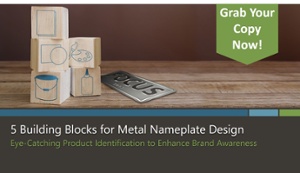When setting out to put a label on a product, most product designers have an idea in mind. Before you send your buyers off to submit a purchase order, you need to pull the specs together. That's not always easy to communicate.
Here are some criteria to be sure everyone is on the same page so that your product identification displays the right message.
Communication with Your Team = Understanding of Expectations
Throughout the process of nameplate design, decision making will be required to move the project forward. Artwork proofs, color chips or pre-production prototypes are all potential items which will need agreement and sign-off to move forward. Be sure that clear expectations are understood on the objective and look of your nameplate or label. Things to be on the same page about include:
-
What material is the nameplate or label needed to be made from? The most common metal used for nameplates, ID Plates and badges is aluminum since it is lightweight and recyclable. Other metals like brass or stainless steel can be used depending on the type of application. Lightweight flexible plastic materials can be reviewed as well, especially if backlit graphics or functional buttons are needed.
-
What size and shape is it? Many logos offer clear indication for the shape that is best used when translated into decals or emblems. When the shape is not obvious, use the product design to help define what the nameplate or label will look like. Where the emblem is placed can provide the dimensions and narrow down the choices.
-
How will the nameplate attach to your product? Deciding how to attach your nameplate will depend on your specific application. Many times the answer is simply a peel and stick adhesive or to pierce holes which allow for assembly with rivets or screws. The type of mating surface and environmental exposure can be factors in determining the best solution.
-
Are there requirements for pre-production or first article samples that are needed? Production quality prototypes and samples allow you to fine tune designs and ensure the right look for your nameplate, label or overlay.
- Do you have artwork ready to submit for quotation? The artwork file is one of the most important pieces of communication with your nameplate supplier. This details the dimensions, colors, decoration, graphics that are needed so that your message and look is carried to the market correctly. Important elements of artwork include:
- Color callouts - Specify color with specific Pantone (PMS) color and their locations. If PMS color is not available, provide a reference to the color target.
- Fonts - Convert to curves and send all fonts with the artwork files to avoid any font discrepancies.
- Gloss level - Specify whether all over or selective and if low (matte) or high gloss is required.
- Graphics and images - Save all images at high resolution, at 100% scale and in vector format.

How Can We Help?
All these aspects make up good nameplate design and communication between your departments and us as supplier. Be careful to consider all without sacrificing one for the other. If you’re looking for recommendations, we can help.
Related Posts
3 Things to Expect from Every Nameplate Project
3 Ways to Get Your Product Noticed
5 Reasons You Need a Nameplate for Product Identification
Common Shapes for Nameplates and Labels



